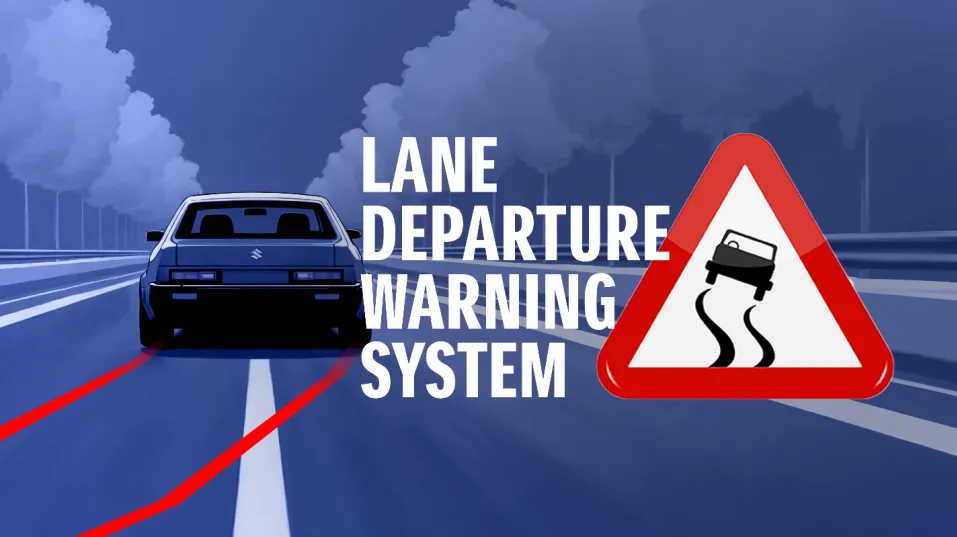Lane Departure Warning System (LDWS) & How Does It Works?

The lane departure warning system helps you avoid crashes if you drift out of your lane. The system LDWS is a smart feature that warns drivers to stay in their lane & avoid accidents.
It’s like shields for your car and helps prevent accidents and keep you & your loved ones safe if something unexpected happens. Airbags and good brakes are examples of these safety features.
What is a Lane Departure Warning System?
A Lane Departure Warning System is a safety feature that alerts the driver when their vehicle unintentionally drifts out of its lane. It uses visual, audible, or haptic warnings to prompt corrective action and prevent unintentional lane departures.

How Does a Lane Departure Warning System (LDWS) Work?
- Detecting lane markings: As you drive, the camera monitors for the white/ yellow lines on both sides of your car.
- Monitoring vehicle position relative to lanes: The computer looks at where your car is between those lines. It's always figuring out how close you are to the edges of the lane.
- Issuing warnings when the vehicle drifts without signalling: Basically, if your car starts drifting out of its lane & you didn't use your blinker, the car will tell you to watch out!
Key Parts of Lane Departure Warning System:
- Cameras and Sensors: Most LDWS use cameras, usually placed near your rearview mirror, to constantly watch the road ahead. Some systems might also use other sensors.
- Lane marking detection: The system's computer is programmed to recognise the lines on the road. It looks at the pictures from the camera to tell the difference between solid lines and dashed lines.
- Software for monitoring vehicle position: The main part is the smart computer program that takes the information from the cameras and sensors. It keeps track of exactly where your car is with the lane lines.
Types of Lane Departure Warnings

LDWS usually gives you different types of alerts to get your attention:
- Visual Alerts: If you start driving outside the lines on the road without using your blinker, a light or picture will pop up on your dashboard to warn you.
- Audio Alerts: You might hear a beep or a special sound to warn you. The sound can be different in different cars.
- Haptic Feedback: Some advanced systems give you a feeling. This could be a vibration in your steering wheel or a little push in your seat to let you know you're drifting.
These different warnings help you notice quickly and take action to steer back into your lane.
Benefits of Lane Departure Warning Systems
Lane Departure Warning System is a core feature of ADAS, which includes technologies that assist drivers in driving and parking functions to improve safety. Using a Lane Departure Warning System has many good points for road safety:
Reduction in Lane Departure Accidents
This feature helps prevent crashes by warning you when you accidentally drift. It makes it less likely you'll hit other cars, things on the side of the road, or cars coming the other way.
Enhanced Driver Awareness and Safety
LDWS reminds you to stay in your lane. This can help you focus more and be more alert, especially on long drives or when the road is boring and you might lose concentration.
Lower Risk of Collisions with Other Vehicles
When you accidentally leave your lane, you can easily bump into other cars. LDWS helps reduce this risk by warning you.
Added Support During Long Drives or Driver Fatigue
Long drives can make you tired, and tiredness can make you less alert. LDWS gives you an extra helping hand to stay in your lane when you might be feeling sleepy. This is a big help in preventing accidents caused by drowsy driving.
Limitations & Challenges
While LDWS is great, it's good to know its limits and some problems it might face:
- Needs Clear Lane Lines: The system works best when the lane lines on the road are clear & easy to see. If the lines are faded or gone, the system might not work properly.
- Not as Good in Bad Weather: Heavy rain, fog, or even very bright sunlight can make it harder for the camera to see the lane lines. In these situations, the system might not work.
- Might Give False Alarms Sometimes: Sometimes, the system might give a warning even when you're not really drifting out of the lane. This can happen if you're driving close to the edge of the lane or on roads with unusual lane markings.
- Don't Rely Too Much: It's important to remember that LDWS is there to help you, but you still need to pay attention and be in control of your driving. Don't become too dependent on the system.
Difference Between Lane Departure Warning & Lane Keeping Assist
There are two similar but different systems: Lane Departure Warning and Lane Keeping Assist. Let's understand the difference:
- Lane Departure Warning (LDWS): This system warns you if you are drifting out of your lane. It doesn't do anything to steer the car itself. It just alerts you to take action.
- Lane Keeping Assist (LKA): This system does more. It not only warns you but also helps you stay in your lane by gently steering the car back if it senses you are drifting.
- When Each System is Useful: The LDWS system is helpful when you might get distracted for a moment or feel a little tired. It gives you a quick reminder to get back in your lane. LKA is even more helpful if you don't react to the warning quickly enough or if there's a strong wind pushing your car. It actively helps you stay in your lane, giving you extra support. So, the LDWS system just warns, while the LKA actively helps steer. Both are good for making driving safer.
